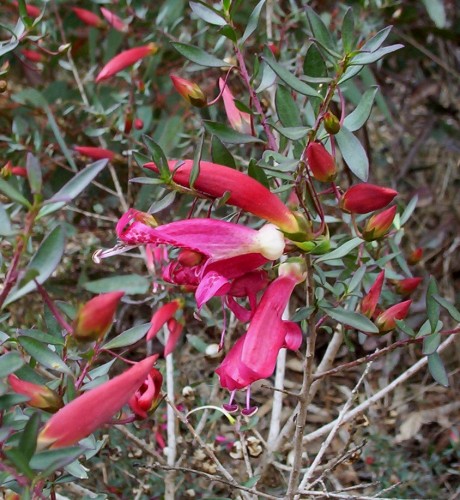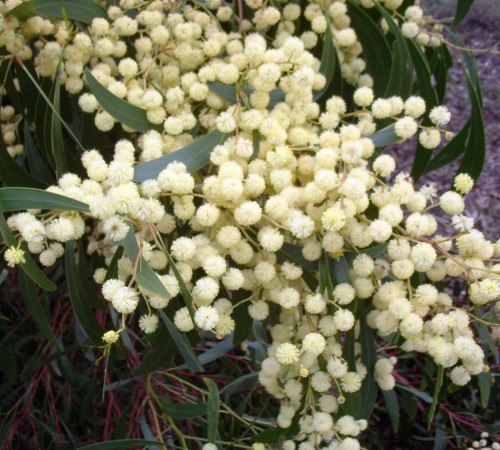Disphyma crassifolium (Rounded Noon-Flower)
The leaves seem to take on the reddish hew when it is in a dry position.
Rescuing More Plants
Poor little grass tree from the previous post. I realised that it has been mown every spring for the last five years. It hasn’t had a chance. Now that I have rediscovered it, I am determined to give it some TLC to see if it will achieve some size.
There is one minor problem. It is in the spot where I want to grow some Banksias. I am not sure that Xanthorhoea and Banksias go together. I suppose in the south east, Banksia ornata and Banksia marginata both have Grass Trees in the vicinity.
Today has been a “rescue plants day”. I have some Geraldton Wax (Chamaelaucium ‘Meringur Mist’) which I want to use as a hedge plus windbreak. I think this Geraldton Wax will manage if we have heavy frosts again. It is certainly a drought tolerant species. It originated in a garden at Meringur, south west of Mildura which is a frosty location. I have found that the frost rating given to species is only valid in times of normal rainfall. In a drought year, the frost damage can be quite severe.
There was a frost warning for here tonight. It is quite likely that my tomato and Zucchini plants may suffer.
Eremophila maculata compact form (Emu Bush)
This compact form of Eremophila maculata is a delight. It only grows about 60cm tall by about the same wide. The flowers are out of proportion to the size of the plant, being the same size as those on Eremophila maculata (Spotted Emu Bush).
All the desirable qualities apply to this plant. It is small, frost and drought hardy and lime tolerant. I think this plant flowers for a much longer period than the standard Eremophila maculata. Everyone admires the brilliantly coloured flowers. Like all Eremophilas, it benefits from light pruning or trimming from a young age.
The Mallee Ringnecks adore it and they can’t be wrong. It was an amusing sight, which we caught with the camera, to see one of the locals fly to the vicinity of the bush, waddle up to it and proceed to pick the flowers, get the nectar from the base of the tube and drop the flower to the ground before proceding to the next flower. The ground surrounding the bush was littered with chewed flowers. Destructive little beast! Incredibly this bush produces so many flowers that the chewed ones were not missed.
Acacia pycnantha (Golden Wattle)
These are making a great splash of colour around the country side now. We have a couple and when the seed pods set and seed is ripening, the galahs have a great feed from them. Unfortunately it does not deter them from the almond trees. One day I would like to have just one feed from the tree, instead of these freeloaders getting the lot.
However I have found a few trees that have cream flowers rather than the golden yellow balls. The trees still seem to have the same form, although here they don’t grow as tall as they might in a higher rainfall area. In a good season we do get seed germinating near the parent tree. This winter has been so dry that it won’t happen this year.
In general Acacias make great plants for windbreaks. Those trees that get artificail watering from, say, a sprinkler on a lawn, don’t seem to live as long as those in the bush.
Australian Native Plants and Frost
I arrived home today from a few weeks enforced convalescence at daughter’s home in the mid north of the state. On many of my gentle walks with her dog I was able to observe the frost damaged plants in the district.
My daughter has a large Melaleuca nesophila in her front yard on the high side of a slope. It flowers wonderfully each year. No sign of burning anywhere on the very large shrubby tree. On the side fence the neighbour has one as does the neighbour on the back fence. Both large shrubs have been severely frost burnt. Yet, in the same yard over the back fence, the lemon tree looks unscathed. I have come to the conclusion that I don’t understand the vagaries of frost. (Just checked my references and it appears that they are damaged by heavy frost. I guess I assumed that because it is such a hardy plant that it would be frost tolerant.)
I thought one could not kill old fashioned marguerite daisies, or geraniums, but both have been severely burnt in daughter’s yard. Both plants have sap in the stems we discovered when tidying some plants so we are hopeful that there will be regrowth. Left the geranium untouched until the frosts have finished as some new growth appeared at the base of the plant and the burnt bits appear to be giving some protection.
I hate to think what the situation is further north where the temperatures dropped even lower.


